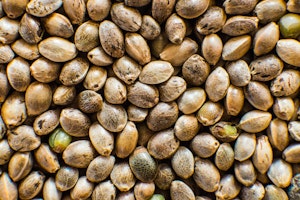
You’ve probably enjoyed a cannabis-infused treat or two – from brownies reminiscent of your college days to gummies that are more sophisticated than candy shop fare.
Today, cannabis has made its way into everything from our late-night snacks to gourmet meals, solidified as a noticeable culinary trend. But with this rising trend of edibles, a critical and classic societal-backed question emerges: Could these cannabis treats be fast-tracking the aging process?
We’re here to uncover the science behind cannabis edibles and their potential effects on aging, providing clarity on whether the beloved cannabis edible is more than just a culinary delight.
Edibles And Aging: Is There A Link?

The interplay between the consumption of cannabis edibles and the aging process is an area of growing interest and complexity within academic and medical research circles.
Cannabinoids – the active compounds found in cannabis edibles – are renowned for their myriad health benefits, notably in reducing inflammation and alleviating pain.
A 2022 study published in MDPI’s Cells highlighted that cannabinoids like CBD and THC contributed to the increased growth of human skin cells and reduced aging indicators. Similarly, a study published this year indicated that CBD has the potential to significantly improve memory in animal models of Alzheimer’s disease.
Conversely, THC, the psychoactive element in cannabis, has raised concerns for potentially accelerating aging processes, including DNA methylation, and adversely affecting cognitive functions such as memory and decision-making. The link between long-term use of THC-rich cannabis and cognitive decline suggests that while its immediate effects may be fleeting, the enduring impacts could be far more substantial and significant.
Thus, the debate surrounding the impact of edibles on the aging process remains unresolved. While current research presents a dichotomy – underscoring the rejuvenating potential of certain cannabinoids against the backdrop of concerns tied to prolonged THC consumption – a conclusive answer remains out of reach.
What Happens To Your Body When You Eat Cannabis Edibles?
Indulging in a THC-infused gummy or a brownie initiates a complex journey throughout your body. It starts in the mouth, where saliva breaks down THC (tetrahydrocannabinol). As the
edible moves to the stomach, digestive enzymes, and gastric juices further disintegrate it. The journey continues in the small intestine, where most cannabinoids, including THC, are absorbed.
In the liver, THC transforms into a more potent form known as 11-hydroxy-THC. This conversion is responsible for the more intense and longer-lasting effects of edibles compared to smoking or vaping cannabis.
Post-liver, the cannabinoids disperse across the body. The effects of edibles typically manifest within 30 minutes to an hour after consumption. The journey concludes with the body metabolizing these compounds, eventually excreting them through urine.
Benefits And Risks Of Consuming Cannabis Edibles

Cannabis edibles, medical marijuana, CBD infused gummies and edible pot concept theme with close up on colorful gummy bears and weed buds on dark background
It’s important to understand the dual nature of cannabis edibles.
Benefits include:
- Discretion and convenience – Edibles offer a discreet way to consume cannabis, free from the smoke and smell associated with smoking or vaping.
- Dosage control – With clear labeling, edibles allow for precise dosage control, ensuring a consistent and predictable experience.
- Therapeutic uses – Widely used for their therapeutic effects, edibles are effective for pain relief, anxiety reduction, and as a sleep aid, especially beneficial for chronic conditions due to their prolonged effects.
- Lung-friendly alternative – Edibles present a safer option for those looking to avoid the risks of smoking, making them a preferred choice for health-conscious users.
Risks include:
- Delayed effects – Unlike smoking or vaping, the effects of edibles take longer to manifest, often leading to overconsumption and unexpectedly intense experiences. This delay can be a significant factor in unintended overuse.
- Long-lasting effects – The effects of edibles can linger for up to 12 hours, depending on their potency and type. This prolonged impact is something users need to plan for, especially when engaging in daily activities.
- Unknown long-term effects – Research into the long-term consumption of edibles is ongoing. Concerns have been raised about the potential impact of regular edible use during adolescence, including possible adverse effects on brain development, heart health, memory, cognition, and psychiatric health.
- Variable potency – Even with dosage labels, the actual potency of edibles can be unpredictable. This variability poses challenges in accurately determining their strength and effects, leading to inconsistent experiences.
- Psychiatric and cardiac health risks – For older adults, cannabis use, including edibles, may carry risks such as the onset of chronic psychiatric conditions, cognitive decline, loss of IQ, and increased risk of cardiac events.
These treats come with benefits that garnered widespread popularity, but they also carry potential risks that warrant consideration.
Herb Recommended Products:
READ MORE









